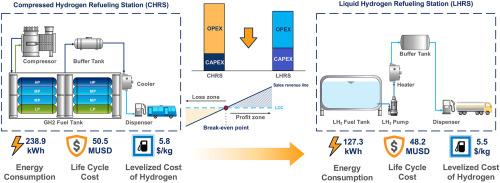压缩氢加气站和液氢加气站热力学性能和经济可行性的比较分析
IF 8.3
2区 工程技术
Q1 CHEMISTRY, PHYSICAL
引用次数: 0
摘要
压缩气体加氢站(CHRS)和液氢加氢站(LHRS)是实现大规模氢流动的两种主要途径;然而,严格的比较评估仍然很少。本研究系统地评估了统一设计条件下800、1000和2000公斤/天产能的热力学和经济特性。结果表明,由于基于泵的增压和降低的冷却要求,LHRS的能耗比CHRS低47%(降低了111.6 kW)。经济分析表明规模经济显著;随着容量的增加,CHRS和LHRS的氢气平准化成本分别下降41.9%(2.42美元/公斤)和51.3%(2.82美元/公斤)。在2000公斤/天时,两种系统的LCOH均低于2.1美元/公斤。LCOH包括氢气采购、资本支出和运营支出。CHRS对电价较为敏感,而LHRS受贴现率的影响较大。这些发现为合理的氢基础设施规划提供了见解。本文章由计算机程序翻译,如有差异,请以英文原文为准。

Comparative analysis of thermodynamic performance and economic viability of compressed and liquid hydrogen refueling stations
Compressed gaseous hydrogen refueling station (CHRS) and liquid hydrogen refueling station (LHRS) represent two principal pathways to enable large-scale hydrogen mobility; yet rigorous comparative evaluations remain scarce. This study systematically assesses thermodynamic and economic characteristics under unified design conditions at capacities of 800, 1,000, and 2000 kg/day. Results show that the LHRS achieves 47 % lower energy than the CHRS (111.6 kW reduction), owing to pump-based pressurization and reduced cooling requirements. Economic analysis indicates pronounced economies of scale; as the capacity increases, the levelized cost of hydrogen (LCOH) decreases by 41.9 % (2.42 USD/kg) for the CHRS and 51.3 % (2.82 USD/kg) for the LHRS. At 2000 kg/day, both systems achieve an LCOH below 2.1 USD/kg. The LCOH comprises hydrogen procurement, capital expenditure, and operating expenditure. The CHRS is more sensitive to electricity price, while the LHRS is affected more by the discount rate. These findings provide insights for rational hydrogen infrastructure planning.
求助全文
通过发布文献求助,成功后即可免费获取论文全文。
去求助
来源期刊

International Journal of Hydrogen Energy
工程技术-环境科学
CiteScore
13.50
自引率
25.00%
发文量
3502
审稿时长
60 days
期刊介绍:
The objective of the International Journal of Hydrogen Energy is to facilitate the exchange of new ideas, technological advancements, and research findings in the field of Hydrogen Energy among scientists and engineers worldwide. This journal showcases original research, both analytical and experimental, covering various aspects of Hydrogen Energy. These include production, storage, transmission, utilization, enabling technologies, environmental impact, economic considerations, and global perspectives on hydrogen and its carriers such as NH3, CH4, alcohols, etc.
The utilization aspect encompasses various methods such as thermochemical (combustion), photochemical, electrochemical (fuel cells), and nuclear conversion of hydrogen, hydrogen isotopes, and hydrogen carriers into thermal, mechanical, and electrical energies. The applications of these energies can be found in transportation (including aerospace), industrial, commercial, and residential sectors.
 求助内容:
求助内容: 应助结果提醒方式:
应助结果提醒方式:


